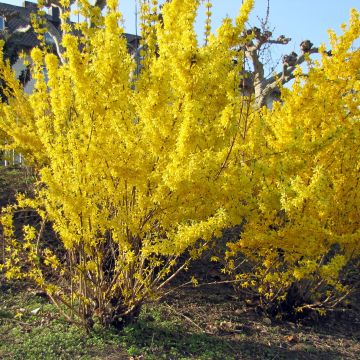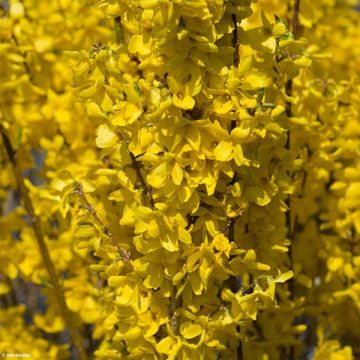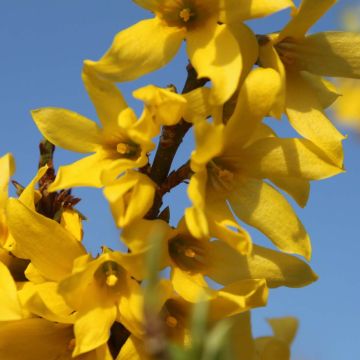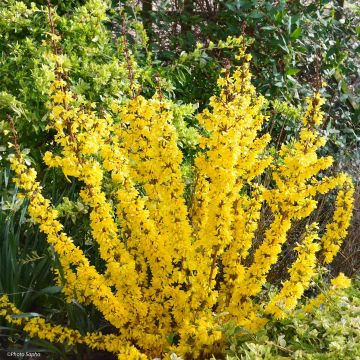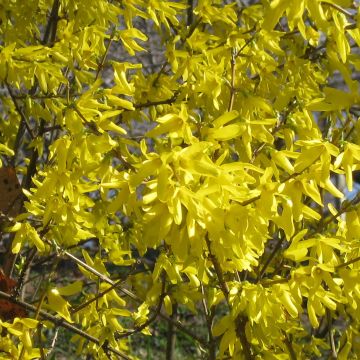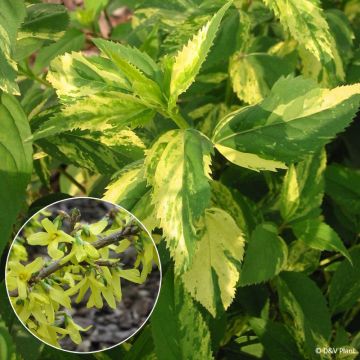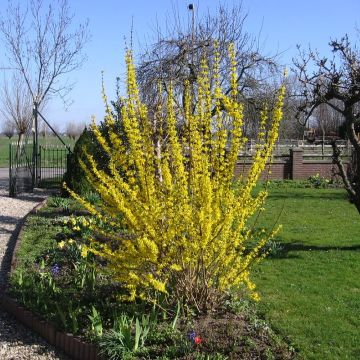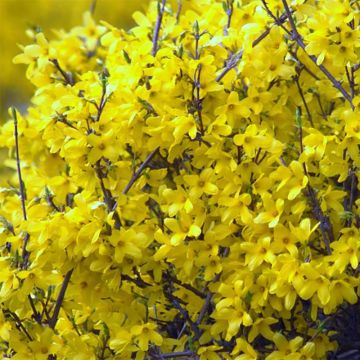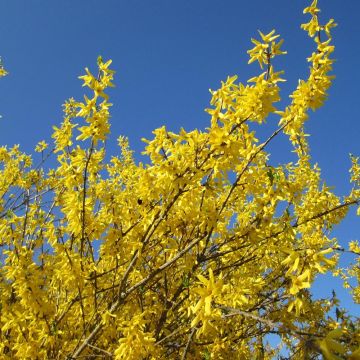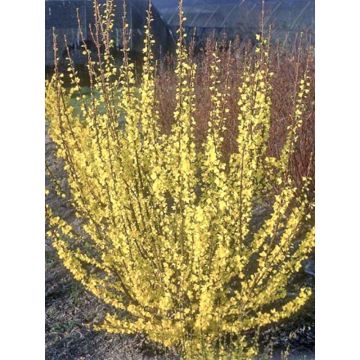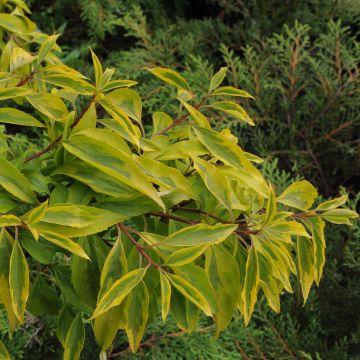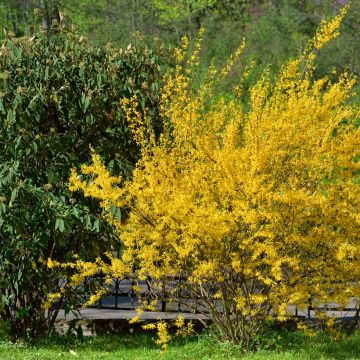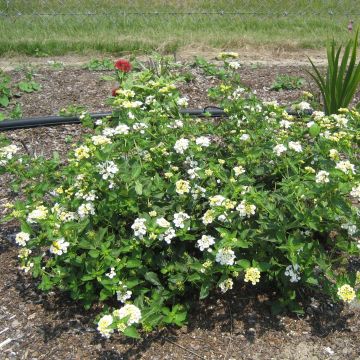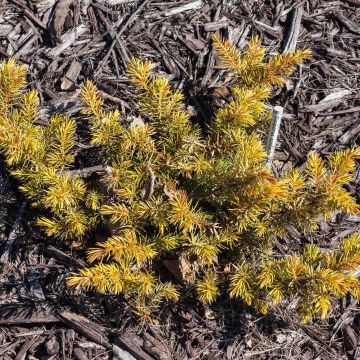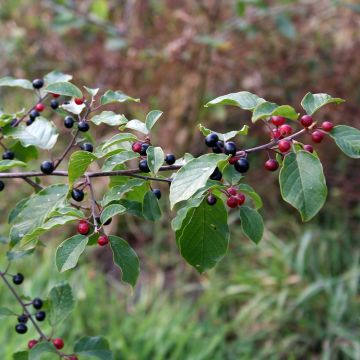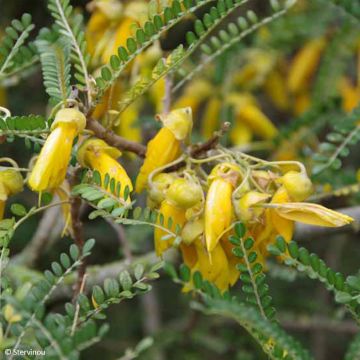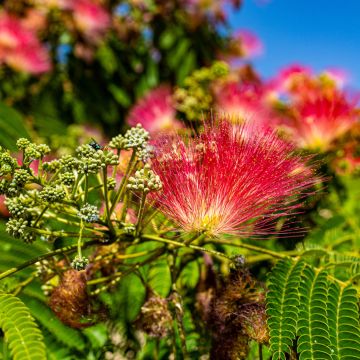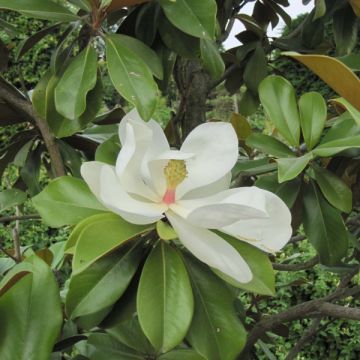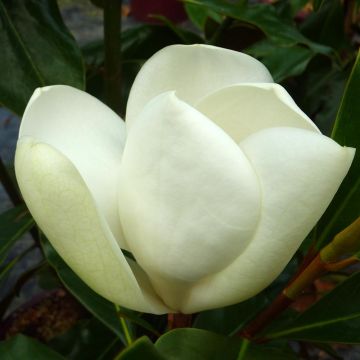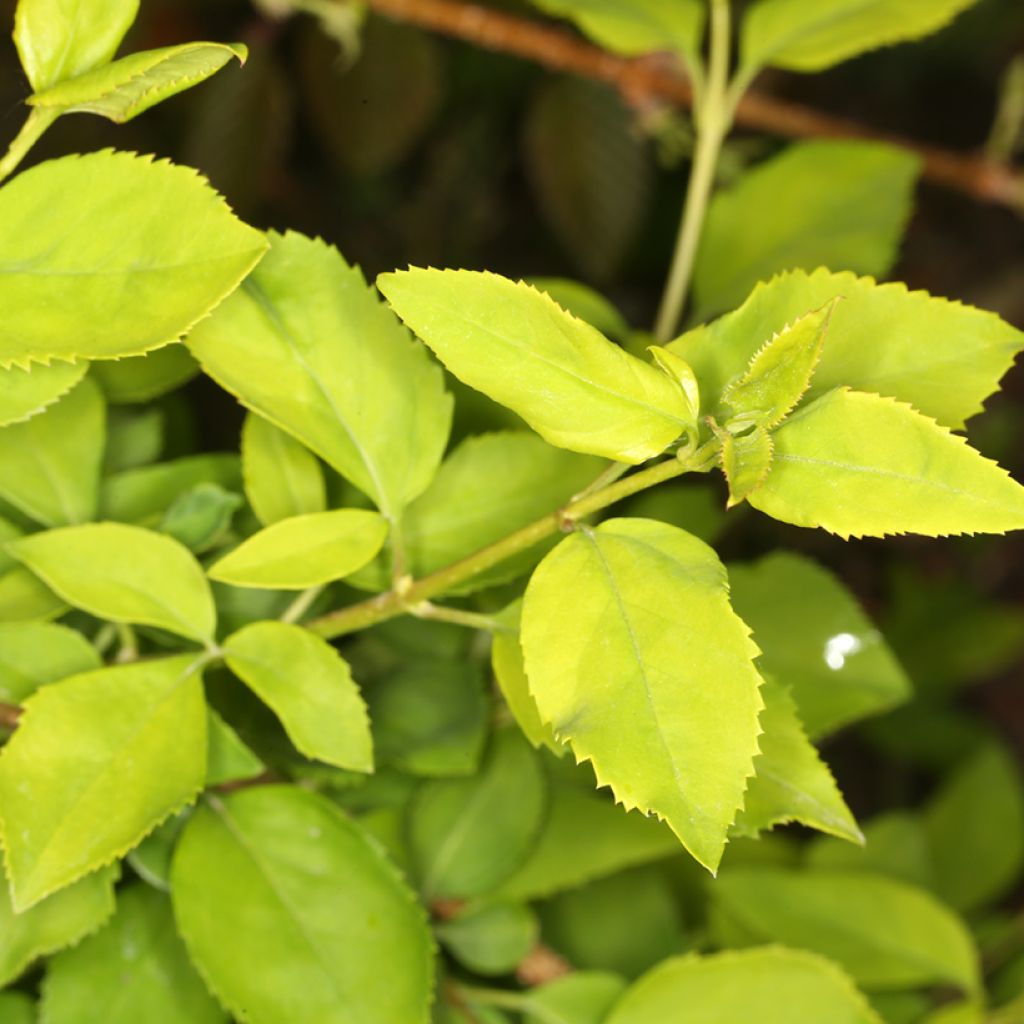

Forsythia suspensa Aurea - Weeping Forsythia
Forsythia suspensa Aurea - Weeping Forsythia
Forsythia suspensa Aurea
Weeping Forsythia, Golden-Bell
Why not try an alternative variety in stock?
View all →This plant carries a 24 months recovery warranty
More information
We guarantee the quality of our plants for a full growing cycle, and will replace at our expense any plant that fails to recover under normal climatic and planting conditions.
From €5.90 for pickup delivery and €6.90 for home delivery
Express home delivery from €8.90.
Does this plant fit my garden?
Set up your Plantfit profile →
Description
The Forsythia suspensa 'Aurea' is a very rare form of a weeping Paris Mimosa, a shrub much less known than its hybrids the Forsythia x intermedia. It is characterised by long, flexible and arched branches, a light yellow spring foliage, and a finer and lighter flowering than that of the classic varieties, appearing on bare branches in early spring. In the garden, it is used in the same way as a winter jasmine.
The Forsythia suspensa 'Aurea' is a natural mutation of the weeping forsythia. This species is native to China, present in the provinces of Anhui, Hebei, Henan, Hubei, Shaanxi, Shandong, Shanxi, and Sichuan. In nature, it is found in thickets or grassy areas, on slopes, as well as in rocky ravines, between 300 and 2200 metres above sea level. The Forsythia suspensa has been cultivated for a long time in China and Japan, both for its ornamental qualities and its uses in traditional medicine. This species was the first to be introduced to the West, around 1784. It is a deciduous shrub of the olive family. Hybridised with the species Forsythia viridissima by Thomas Meehan in Philadelphia in the 1860s, it gave rise to the Forsythia x intermedia, commonly planted in our gardens.
The Forsythia suspensa 'Aurea' will reach an average of 1.80 metres in all directions if left unchecked. Its long, flexible and arched branches, if trained against a wall, can however reach over 3 metres in height. This shrub naturally forms a "fountain". Its branches are yellow to grey-brown in colour, glabrous, and hollow. Flowering takes place between March and April, before the appearance of the foliage. The flowers are solitary or grouped in clusters of 2 to 6. They are finer than those of classic forsythias and less dense on the branches. Their colour is also a lighter yellow. After pollination by insects, small oval-shaped fruits measuring 1.2 to 2.25 cm in length form. The leaves are entire or trifoliate. They measure 5 to 10 cm in length and 2 to 5 cm in width, with a dentate margin. In the 'Aurea' form, the leaves are yellow when they first appear in spring, then they turn slightly green in summer. They turn orange-yellow in autumn before falling.
The Forsythia suspensa 'Aurea' is hardy and grows in any type of soil that is not too dry, even very chalky, but well-drained. This weeping variety will have a great effect on a slope or above a low wall where it will cascade down. It can also be trained to climb a wall next to a flowering quince 'Rubra', by training its branches. To accompany it, consider the tree clover (Lespedeza thunbergii), the Buddleja lindleyana, and the winter jasmine. In early December, cut a branch or two and put them in a vase, they will bloom for Christmas.
Report an error about the product description
Plant habit
Flowering
Foliage
Botanical data
Forsythia
suspensa
Aurea
Oleaceae
Weeping Forsythia, Golden-Bell
Syringa suspensa Aurea
China
Other Forsythia
Planting and care
The Forsythia suspensa 'Aurea' enjoys a sunny (but not scorching) exposure as well as partial shade, and is content with an ordinary soil, not too dry, but properly drained. After flowering, every 2 years, prune it to promote a more compact habit and prepare for the next flowering. In the first 3 years, a simple cleaning of dead, thin or poorly positioned stems will be sufficient.
Planting period
Intended location
Care
This item has not been reviewed yet - be the first to leave a review about it.
Striking foliage shrubs
Haven't found what you were looking for?
Hardiness is the lowest winter temperature a plant can endure without suffering serious damage or even dying. However, hardiness is affected by location (a sheltered area, such as a patio), protection (winter cover) and soil type (hardiness is improved by well-drained soil).

Photo Sharing Terms & Conditions
In order to encourage gardeners to interact and share their experiences, Promesse de fleurs offers various media enabling content to be uploaded onto its Site - in particular via the ‘Photo sharing’ module.
The User agrees to refrain from:
- Posting any content that is illegal, prejudicial, insulting, racist, inciteful to hatred, revisionist, contrary to public decency, that infringes on privacy or on the privacy rights of third parties, in particular the publicity rights of persons and goods, intellectual property rights, or the right to privacy.
- Submitting content on behalf of a third party;
- Impersonate the identity of a third party and/or publish any personal information about a third party;
In general, the User undertakes to refrain from any unethical behaviour.
All Content (in particular text, comments, files, images, photos, videos, creative works, etc.), which may be subject to property or intellectual property rights, image or other private rights, shall remain the property of the User, subject to the limited rights granted by the terms of the licence granted by Promesse de fleurs as stated below. Users are at liberty to publish or not to publish such Content on the Site, notably via the ‘Photo Sharing’ facility, and accept that this Content shall be made public and freely accessible, notably on the Internet.
Users further acknowledge, undertake to have ,and guarantee that they hold all necessary rights and permissions to publish such material on the Site, in particular with regard to the legislation in force pertaining to any privacy, property, intellectual property, image, or contractual rights, or rights of any other nature. By publishing such Content on the Site, Users acknowledge accepting full liability as publishers of the Content within the meaning of the law, and grant Promesse de fleurs, free of charge, an inclusive, worldwide licence for the said Content for the entire duration of its publication, including all reproduction, representation, up/downloading, displaying, performing, transmission, and storage rights.
Users also grant permission for their name to be linked to the Content and accept that this link may not always be made available.
By engaging in posting material, Users consent to their Content becoming automatically accessible on the Internet, in particular on other sites and/or blogs and/or web pages of the Promesse de fleurs site, including in particular social pages and the Promesse de fleurs catalogue.
Users may secure the removal of entrusted content free of charge by issuing a simple request via our contact form.
The flowering period indicated on our website applies to countries and regions located in USDA zone 8 (France, the United Kingdom, Ireland, the Netherlands, etc.)
It will vary according to where you live:
- In zones 9 to 10 (Italy, Spain, Greece, etc.), flowering will occur about 2 to 4 weeks earlier.
- In zones 6 to 7 (Germany, Poland, Slovenia, and lower mountainous regions), flowering will be delayed by 2 to 3 weeks.
- In zone 5 (Central Europe, Scandinavia), blooming will be delayed by 3 to 5 weeks.
In temperate climates, pruning of spring-flowering shrubs (forsythia, spireas, etc.) should be done just after flowering.
Pruning of summer-flowering shrubs (Indian Lilac, Perovskia, etc.) can be done in winter or spring.
In cold regions as well as with frost-sensitive plants, avoid pruning too early when severe frosts may still occur.
The planting period indicated on our website applies to countries and regions located in USDA zone 8 (France, United Kingdom, Ireland, Netherlands).
It will vary according to where you live:
- In Mediterranean zones (Marseille, Madrid, Milan, etc.), autumn and winter are the best planting periods.
- In continental zones (Strasbourg, Munich, Vienna, etc.), delay planting by 2 to 3 weeks in spring and bring it forward by 2 to 4 weeks in autumn.
- In mountainous regions (the Alps, Pyrenees, Carpathians, etc.), it is best to plant in late spring (May-June) or late summer (August-September).
The harvesting period indicated on our website applies to countries and regions in USDA zone 8 (France, England, Ireland, the Netherlands).
In colder areas (Scandinavia, Poland, Austria...) fruit and vegetable harvests are likely to be delayed by 3-4 weeks.
In warmer areas (Italy, Spain, Greece, etc.), harvesting will probably take place earlier, depending on weather conditions.
The sowing periods indicated on our website apply to countries and regions within USDA Zone 8 (France, UK, Ireland, Netherlands).
In colder areas (Scandinavia, Poland, Austria...), delay any outdoor sowing by 3-4 weeks, or sow under glass.
In warmer climes (Italy, Spain, Greece, etc.), bring outdoor sowing forward by a few weeks.

































